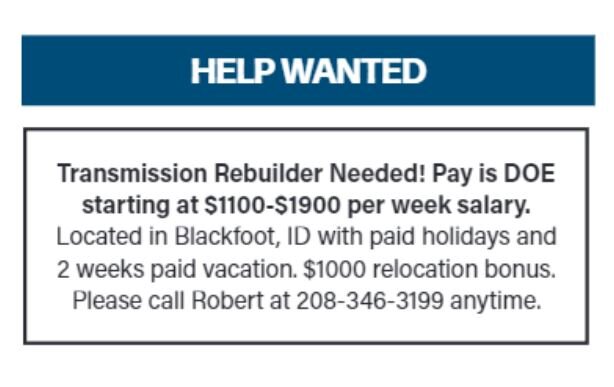-
Posts
644 -
Joined
-
Last visited
-
Days Won
130
Content Type
Forums
AutoShopOwner Articles
Downloads
Blogs
Gallery
Profiles
Events
Store
Links Directory
Shop Labor Rates
Community Map
Everything posted by Transmission Repair
-
Some accounting issues can differ, based on the owner/bookkeeper preferences. This is such a case. There is absolutely nothing wrong with doing it the way you are currently doing it. If you choose to expense it all off, that's OK. All that matters is that you're aware of it and know what's going on. Some business owners want to know every little detail (sometimes called profit centers) about their business. I used to be that way, but because of it, my Chart Of Accounts was a huge list. I finally got tired of it and started consolidating some of the accounts. Judging from what you wrote, I think you are good to go just as you are. No changes needed.
-

Auto Repair Training
Transmission Repair replied to autorepairuniversity's topic in General Automotive Discussion
Your link doesn't work. -
I group anything having to do with computers to run our business into one category. Another category is the same thing having to do with the shop computers to fix vehicles. I used to break it all out and had a butt-load of different categories in my Chart of Accounts (COA) that after a few years grew and seemed to take on a life of its own. After about 15 or 20 years, I had my COA list down to about 40 account categories. It's really easy to break every little thing down to its own category. I just got tired of all the account categories and the high likelihood of miscategorization it engendered. To me, a COA list is your own preference. Some people like to know every little thing, and some do not, like me. The only way you can get into any real trouble is from MISCATORIZING an expense or a Cost Of Goods Sold account. My acid test to answer the question of "Is it a COGS or is it an expense?" is this: "If you didn't have a single customer and did no repairs for a month, would you still have that expenditure?" You would have no parts, no labor, no towing, etc. If the answer is "yes", it's an expense. If the answer is "no" it's a COGS.
-

Would You Hire a Dealer Technician?
Transmission Repair replied to Joe Marconi's topic in Human Resources, Employees
Here are some great ways to interview and hire prospective employees. In addition to having a job application on a shop's career page of their website, also have a video tour of your shop. Additionally, use FaceTime or Zoom for a "virtual" interview online. After that, if you choose, invite them down to your shop for an in-person interview. Make sure you have a list of questions for both the online and in-person interviews. Here's more on the WSJ article that made me think about hiring new employees. Few shops can afford an HR department and we, as shop owners, don't have a lot of practice in the job interview process. I think the best way to get high-quality prospects is by a referral from your current employees. With that being said, it still doesn't make a case for not using the need of video(s) in the hiring process. Make sure you don't over-promise and under-deliver in all facets of the hiring journey. Landing A Job -

How to Afford a $100K Technician
Transmission Repair replied to Transmission Repair's topic in Human Resources, Employees
Here's an ad in the latest (6/24) issue of Transmission Digest. I've paid more. $2,000/wk. or $104k/yr. -
Welcome to the forum! This is where we share and learn from our experiences.
-
First, I'd like to thank you for your monetary support of this group. Membership does so much more than merely pay the bills. Your two previous posts are very insightful. For our members who may feel they need help with setting up KPIs, they can go to https://www.kpi.org/ However, as Joe said, your previous example of helping techs acquire tools can also serve as a template for other member shops. Thanks for the tips! We need more members like you.
-

Would You Hire a Dealer Technician?
Transmission Repair replied to Joe Marconi's topic in Human Resources, Employees
I've only hired 2 dealer technicians and was happy with the results because I already knew what to expect. The reason I say that is I was once a dealer technician myself. One tech applied for a job and the other one, I literally "stole" from a nearby dealership. Hiring a dealer tech gave me more than hiring someone out of a trade school. They know more than the old "righty-tighty, lefty-loosey". Even though they have more experience on a particular car line, don't forget that the vast majority of what they work on is a much newer year model. Their (hopefully) years of experience on a particular car line doesn't help much on the older car make(s) that are so common in the aftermarket and independent shops. They pick up on new things much quicker than trade school students. In both cases, the techs were grateful to NOT be on flat-rate. It was like an instant pay raise from their point of view. I can't think of anything negative about hiring a dealer tech. It may be in both cases, we were hurting pretty bad for a tech. Today, everybody seems to be talking about "the technician shortage." I think a lot of that is because of today's much better industry communication through the internet. Looking back on my 40-year career, I can't think of a time when good technicians weren't in short supply. -
I thought this was a very good article. Before we sold our transmission repair business in 2015, my last hire was coincidentally hired at $104 K/yr. I don't regret it even though it was over 10 years ago. Now, more than ever, such wages have become closer to the norm, not the exception, for a top-tier technician. Read and enjoy. How to afford a $100,000/yr. technician
-

Want to End Your Technician Shortage? Focus on Retention!
Transmission Repair commented on Joe Marconi's blog entry in Joe's Blog
How our industry is currently paying technicians... https://www.ratchetandwrench.com/running-a-shop/human-resources/article/55038486/numbers-how-auto-repair-shops-pay-technicians -
The lure of cheap rent is a universal rookie mistake resulting in a low/no traffic count. Cheap buildings are affordable for a reason. One of the best pieces of business advice I ever got was, "Expensive rent is the cheapest advertising you'll ever buy." From Roy H. Williams in Austin, TX. With a killer location, a shop won't need Repair Pal or Open Bay.
- 8 replies
-
- 1
-

-
- repair pal
- openbay
-
(and 1 more)
Tagged with:
-
I'm really impressed with Hireology.com A very good intro is a 1-hour video at https://youtu.be/2ZF1XWH94xc A 10-page .pdf is at
- 1 reply
-
- 1
-

-
- hire techs
- tech pay
- (and 3 more)
-
I used Google Pay-Per-Click advertising to grab the bull by the horns and CONTROL the work in our transmission shop. I've posted about this before. Normally, our ads would show within a 5-mile radius of our shop. If it got slow, I would increase the radius. If we got really busy, I would either reduce the radius or sometimes PAUSE all PPC ads. Over time, I got really good at it. The purpose of the ads was to get people to call, and we would set an appointment from there. Clicks were, on average, about $12/click and it would take about 3 clicks ($36) to set an appointment. We did that up until my retirement in 2015 when I sold the shop. We were consistently averaging $1.2M/yr. in gross revenue.
-

Are Your Using Multi Tier Labor Rates?
Transmission Repair replied to Joe Marconi's topic in Pricing, Discounts, Labor Rate
No wholesale for other shops. I avoided warranty companies like the plague, mainly because of the hassle factor of plugging up our production. We only did retail jobs and left the rest to other shops to do. We had plenty of work to do.- 6 replies
-
- 1
-

-
- labor rate
- labor profit
-
(and 2 more)
Tagged with:
-

Are Your Using Multi Tier Labor Rates?
Transmission Repair replied to Joe Marconi's topic in Pricing, Discounts, Labor Rate
We had different labor rates for different jobs. Sometimes it was because of the difficulty, and other things like risk. We had our labor rates at the lowest, plain vanilla, straight jobs. If the vehicle had been chipped, twin turbos, high flow heads, exhaust, or deleted emissions, part labor for those types of vehicles carried a higher premium labor rate. For me, it's not just about the money as it was about managing risk. We commonly found when customers make a horsepower/torque range change, the first thing that goes is usually the factory original transmission. With diesels, this is especially true. The transmission simply is the weak link in the drivetrain. They were never meant to handle that much power. Sometimes it was the extra hard parts/upgrades that drove the price up, which is additional parts on top of the increase in labor. Our ARO for major jobs was about $3,600 as of 2015.- 6 replies
-
- 1
-

-
- labor rate
- labor profit
-
(and 2 more)
Tagged with:
-
Welcome Jade!
-
I've said it before and I say it again, we use our Google PPC advertising radius to "throttle our business." Normally, we would be listed at the top of a Google search within a 5-mile radius of the shop. If it got slow, I would increase the size of the radius. If we got slammed, I would even pause our Google PPC ads altogether. If it got slow, I would increase the size of the radius. The largest I've ever gone with our Google PPC program is a 100-mile radius. I know beyond a shadow of a doubt, the Google PPC program works for a transmission repair shop. That's because, in our line of work, it is transactional-based. How it would work for other automotive businesses, where it's usually relationship-based, I can't say for sure. If anybody wants to know that this works, make sure you get hooked up with a call-tracking company and use call tracking where you know, beyond a shadow of a doubt, it's either working or not working. This is true with any type of advertising. Each lead source has a different tracking number. Otherwise, every phone call is just that, another phone call. You have no way of knowing the source of that sales lead. Without call-tracking being a part of any advertising campaign, advertising is just another bill you'd rather do without.




